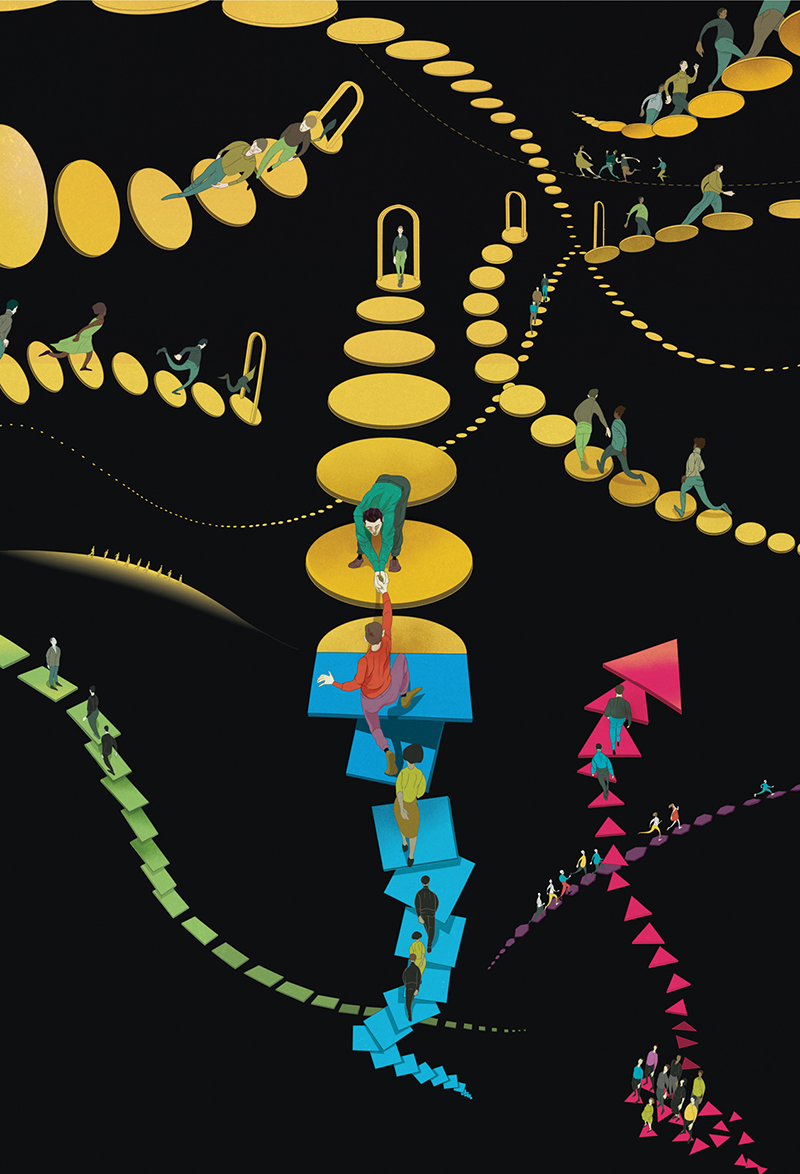
August 14, 2018
On the Edge of Me
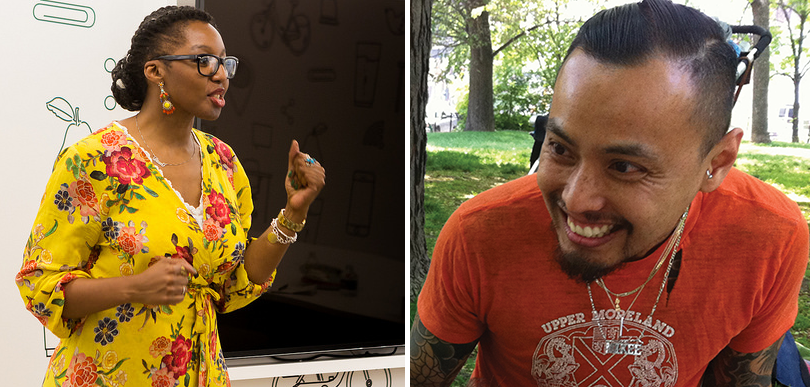
As the recipients of this year’s AIGA Worldstudio scholarship are announced, friends and fellow scholarship jurors, designer Dian Holton and illustrator Marcos Chin, reflect on professional growth, mentorship as personal mission, and why liminal spaces—spaces between the end of one point and the beginning of something new—are really where you want to exist.
Lilly Smith: How did you meet?
Marcos Chin: Did we meet here at AIGA for the scholarship jury?
Dian Holton: I think we did! But I had Marcos bookmarked for a while, because I wanted to use his ilustrations at AARP. It was many, many years later that I was fortunate enough to be in his presence for the scholarship jury the year before last.
MC: I felt like we connected immediately. It was visceral.
LS: When and how were you first introduced to your craft?
MC: Drawing is something I’ve always loved to do, but it wasn’t until I was in art college that I realized this could be a profession I could make money from. Two years after college I started to get regular work as an illustrator. Four years after that, when I moved to New York City, the community here really cemented everything. I started to get more work within illustration. But drawing has always been in my DNA.
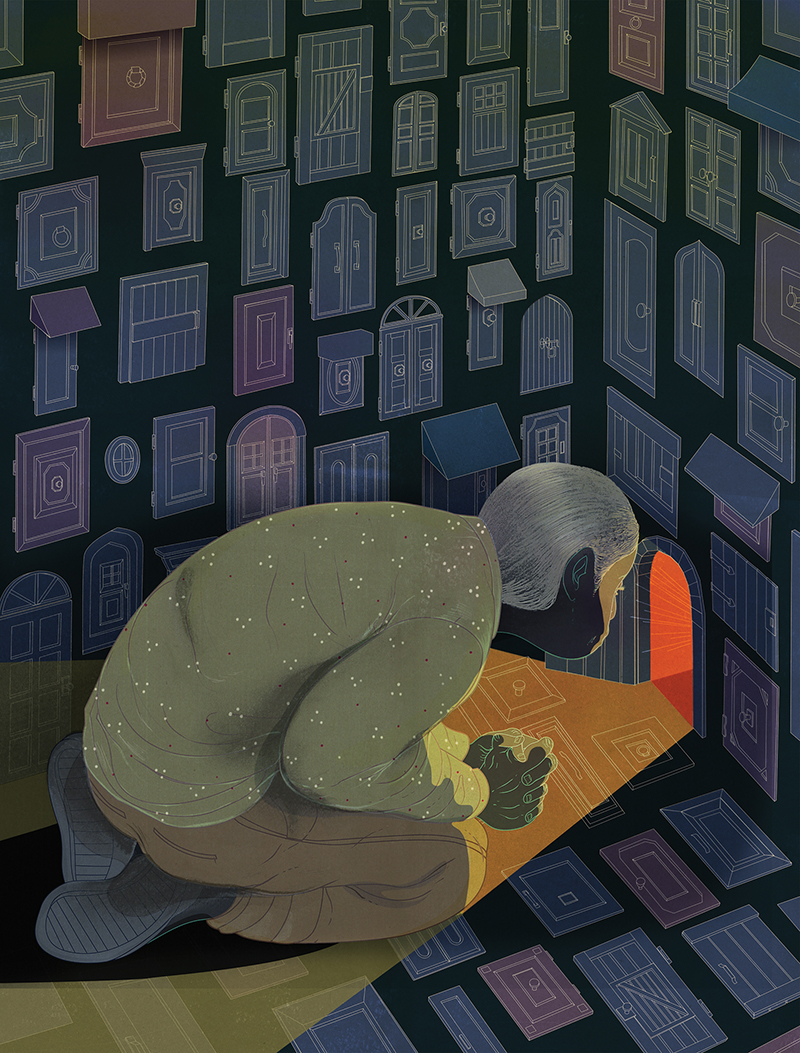
“Big Opportunities in Small Things” for Plansponsor Magazine, Art Director: SooJin Buzelli, Illustration by Marcos Chin
LS: How did you first start finding work when graduated?
MC: I attribute a lot of my successes within my profession through incremental gains. I tried lots of different things—I contacted my instructors and asked them for help; I reached out to friends like Dian who would’ve been junior art directors and junior designers at the time and could put me in touch with the right people. I did a lot of pavement pounding with my portfolio. I did a lot of cold calling. I lied.
I attribute a lot of my successes within my profession through incremental gains.—Marcos Chin
LS: What did you lie about?
MC: I’d call up an agency and say, “I’m going to be in New York City just a short time, can a book an appointment with you?” Or, “Yes I’ve done this kind of project before, of course I can work with you” Those types of things. I’d approach promoting myself from all angles; faking it until you became it.
LS: Does that sound familiar to you, Dian?
DH: It does. I remember faking it. But I’ve always believed in stability and I haven’t been a risk-taker in the sense that I’d just pack my bags and move. I was always like, “What’s the plan?”

“Social Impact Investing” for Dartmouth Alumni Magazine, Art Director: Wendy McMillan, Illustration by Marcos Chin
LS: Dian, when and how were you first introduced to your craft?
DH: My dad majored in accounting and went into the military, but because both my parents dabbled in the arts, I was exposed to it. My dad wasn’t a big fan of my going to an art school. Even now, a lot of people don’t see it as a real profession. So I went to my parents’ alma mater, Florida A&M. As it turned out, the major I wanted—clothing and retailing—wasn’t available anymore. So my default became graphic design and I joined the School of Media, Journalism, and Graphic Arts.
I had a mentor in school who was the art director of our school newspaper and he lured me into media.That interaction with journalism broadcast students allowed me to see another side of design, and I gravitated toward those possibilities. That’s where I’ve stayed. I really did want to go into fashion. I even went back to school and took some courses at Parsons to see if that’s what I wanted to do. So I feel both the fashion side and the media side, which is essentially the graphic design.
LS: I see a similarity between you both in that you have travelled to get to where you are now. Dian, you moved a lot as kid because of your dad’s service in the military, and Marcos, you now live in a different country than where you grew up. Has taking that step outside your own backyard changed your approach to design?
DH: Yes, tremendously. When you live outside of your hometown, it gives you a different perspective on everything: on the world in general; politics, culture. You learn how to adapt. It becomes easier to pivot and you start to see things from a different lens. The more people you engage with, the more work you do, the more well-rounded you become.
That definitely plays into the work you do as a creative. You don’t just create pretty things. Your work becomes more intentional. You think about who is going to receive it and how they’re going to receive it. Is it offensive? Is it not? Do you care? Are you trying to evoke empathy? Empathy comes from being exposed to other people, environments, and cultures. It helps in the work that I’ve done, especially as it relates to media. Media should also be true. The more exposure you have to the communities you’re aiming to reach, the easier it will be to go into those communities, connect with them, and provide the visuals that represent what you do and who you support.
When you live outside of your hometown, it gives you a different perspective on everything: on the world in general; politics, culture. You learn how to adapt.—Dian Holton
MC: Ditto. When I moved to New York City, a different and profound stage of learning began for me. I always thought that going to art school was where my learning would happen, but in hindsight, it was four years of foundation. It wasn’t until I left my hometown, as Dian said, moved here, and met a diverse range of artists, illustrators, and designers that I learned a new way of seeing and thinking. I started to approach art through a lens. When you’re at the edge of a space—even if you’re pushing yourself to the point where you might fail—you learn how much further you need to go next time.
Coming from a working class family, being gay, I’ve always been on the edges, in liminal spaces. I don’t think the choices I made back then were intentional, but they were a way to survive until I came to the point where I can recognize that those qualities were actually strengths that moved me forward. Now I’m trying to create a space for others to realize that the edge is not necessarily the end, it’s the beginning.
When you’re in a place of comfort and stability—I mean, come on. For my personality at least, it’s not something I even enjoy. I love New York City, but now that I’ve been here for thirteen years, I’m starting to dream about moving outside of it. I can feel that I’m on the edge of me.

“The Wealth Divide” for The New York Times, Art Director: Corinne Myller
LS: How can others create those liminal spaces for themselves?
DH: First, students should do internships in an area that they’re not familiar with. Do a variety of them so you can weed out what you don’t want to do.
Second, volunteer at creative spaces outside of the design world. I volunteered as a docent at the National Zoo way back in the day when they had their first set of cheetah cubs. As a docent, you only have a couple seconds to gain the interest of visitors. I took that experience and transferred it to the work that I do. In media, you only have a short window of time to capture someone’s attention and give them a story. I learned a lot from the experience of stepping outside of media and engaging with people that aren’t designers. I also learned a lot about cheetahs. And it’s a great talking point on a resumé.
Mixing up where you intern and volunteer will give exposure to a person who may not have gotten it coming up like Marcos and I did. As Marcos mentioned, when you are uncomfortable you are learning. Not everything should be a cakewalk.
MC: The one thing I want to add to Dian’s point is that, in addition to students seeking out opportunities, it’s important for adults and teachers to become a catalyst. My parents had little affinity toward art, so I was really fortunate to have people in my life who helped me see that the talent I had at ten years old wasn’t elusive. It could be something much greater if it was nurtured.
Near the end of high school, I hadn’t come out as gay yet. But looking back, a lot of the work was kind of homoerotic. When you’re making work subconsciously, that reflects a part of yourself that’s uncomfortable. That’s where the teacher steps in to make sure you don’t feel strange or apologetic. When you’re young and you come from a place with few resources you need a support system. It was because of the support I got in my twenties I started to volunteer for ACAS (Asian Community AIDS Services). I met a lot of people there who were completely outside of my space, but within that office there were adults who taught me about goal setting. I learned more than I ever expected to.
LS: What have you learned from being in mentorship roles?
DH: Not every teacher can mentor. So be aware of what your skill set is and give it a try.
What each person gets out of a mentorship depends on the pairing. Seven years ago, I launched Shine, a traditional one-on-one mentoring program, with my colleague Kerri Sarembock. Some of the mentors in the program didn’t have direct reports at their job or they were independent contractors, so did they hadn’t had the opportunity to mentor before. This opportunity allowed them to establish their management, leadership, and directional skills. Mentors learned how to be patient and resilient, or to praise. I’m always happy to see mentees grow and turn into leaders; to be better than where they were when they started.

SHINE, peer-to-peer mentoring program that Dian oversaw for AIGA DC.
LS: In a way, you’ve both made mentorship your personal mission. Why on an individual level was this component so important to who are as a designer and an illustrator?
MC: One thing that’s been consistent throughout my teaching experience is that there are moments that happen after class where students and I start to have conversations beyond the classroom. As a teacher, I really enjoy it. I wanted more than just putting up sketches and talking about finals. Let’s talk about the things that happen after you graduate. That’s equally as important as school.
That was one of the reasons I wanted mentorship to occupy more space in my profession. Though I love what I do as an illustrator, there’s a human component that’s missing. I’ve come to these moments where I wonder, “Is this it?” I want to be more connected and engaged to the people that are around the spaces that I inhabit. I became a mentor in a more intentional way because I get to have conversations with people who are also figuring out what meaning their works brings to them and how it can impact others.
DH: I kind of fell into mentorship. Mira Azarm, a former AIGA DC president gave me a board role and tasked me with mentoring. Outside of AIGA, one of the reasons I’ve taken on mentoring is that there’s a lack of people of color in the design community. People are looking for role models whom they can identify with. There aren’t a lot of African American women in media. It underscores the need to throw the rope back and help those behind you get to the next hurdle.
There aren’t a lot of African American women in media. It underscores the need to throw the rope back and help those behind you get to the next hurdle.—Dian Holton
LS: Marcos, I’ve learned a lot from your posts on social media—from your five year plan, and your second drafts of five year plans. Why did you start making them and how have they impacted the way you think about a career path?
MC: I initially developed my five-year plan with my friend and a great illustrator Yuko Shimizu. We co-teach a class at SVA. We made a five-year plan alongside our students and shared it with our class. The five-year plan is perfect for me because I’m a list person and in order to achieve particular goals I need guide posts along the way. I realized that when I didn’t achieve some of my goals it was because I didn’t want to pursue them anymore. So why would I continue to stick with them when I could pivot? Although my plan will still happen over five years, it’s ok if it needs to be rewritten before then.
When I write these plans it gives me distance from the storm. I can simplify and get to the essence of something that feels much more complicated at the time. It works for me.
LS: Is this something you’d recommend to students to try?
MC: Totally. But something I always say to my students is that one of the most important things you can do is be open-minded. Inflexibility will kill you. If there isn’t a community for something you want to do, create it.
LS: How do you overcome self-doubt?
MC: I create more personal work. The moment that I started to become intentional with my curiosity by creating personal work alongside of my commercial work, that really helped to stave off the demons. When you’re not making for an audience and you’re not thinking about money and success and fame, and you’re just having fun, that lifts your spirit and your energy and creeps into the professional space. If I’ve had self-doubt, it feels less so because my spirits are up. It’s an abstract way to describe it but that’s always helped me.
LS: What’s a piece of advice you’d give to someone starting out in illustration or design?
DH: Research, volunteer, and network. And repeat.
MC: As a freelance illustrator, I’ve learned the importance of community. There may be those dry times where you’re not commissioned for work and it’s really important to continue to draw and put it out there. Commercial art is relational. You need other sets of eyes to look at it. One of the most valuable lessons I’ve learned is to not lock yourself in your studio. You have to seek out community, share your work, and learn how to speak about it.
DH: That interaction is key because putting yourself out there to other people can turn into jobs, commissions, and even friends.
Observed
View all
Observed
By Lilly Smith
Related Posts

Design Juice
Rachel Paese|Interviews
A quieter place: Sound designer Eddie Gandelman on composing a future that allows us to hear ourselves think
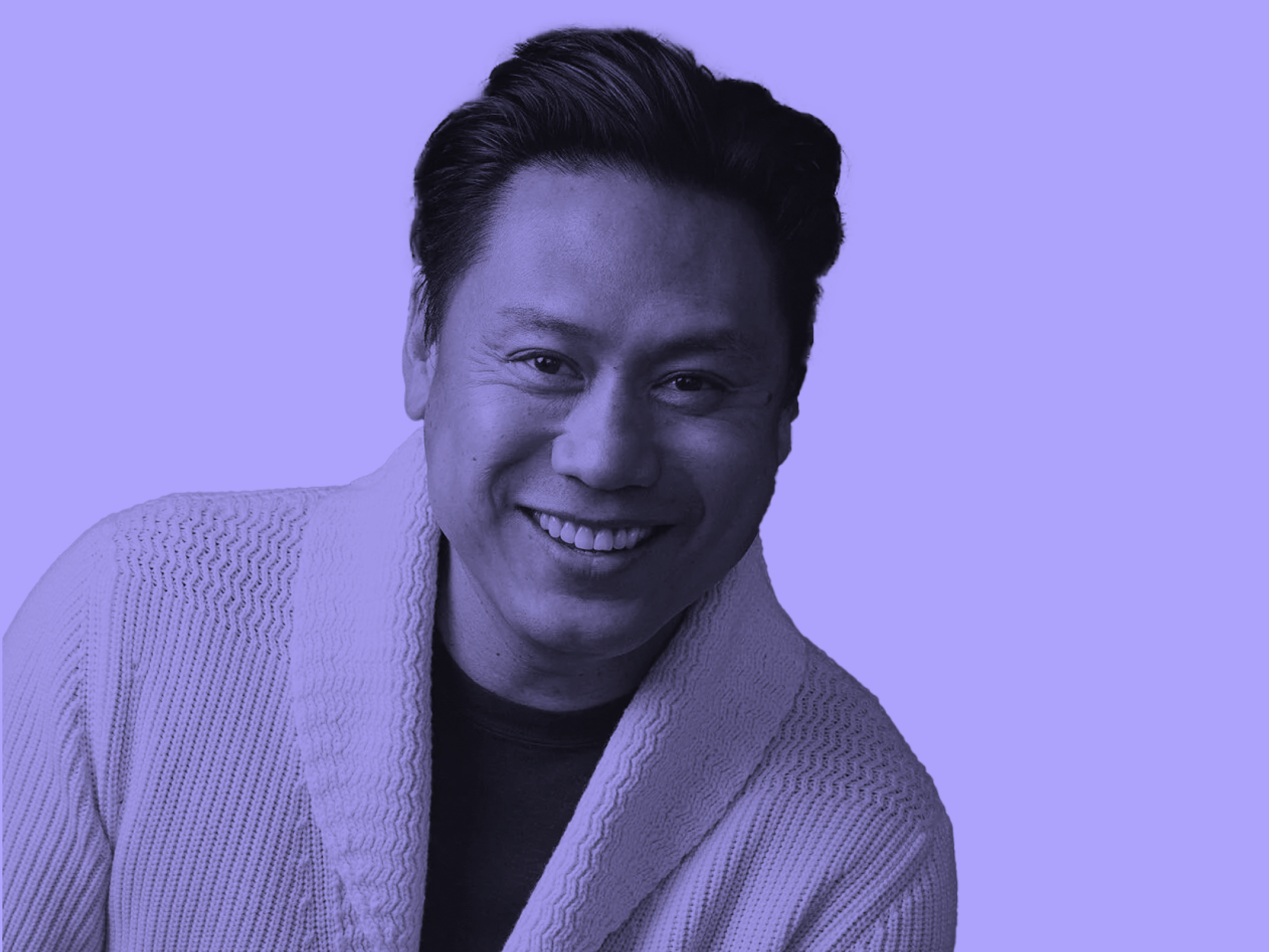
Design of Business | Business of Design
Ellen McGirt|Audio
Making Space: Jon M. Chu on Designing Your Own Path

Design Juice
Delaney Rebernik|Interviews
Runway modeler: Airport architect Sameedha Mahajan on sending ever-more people skyward
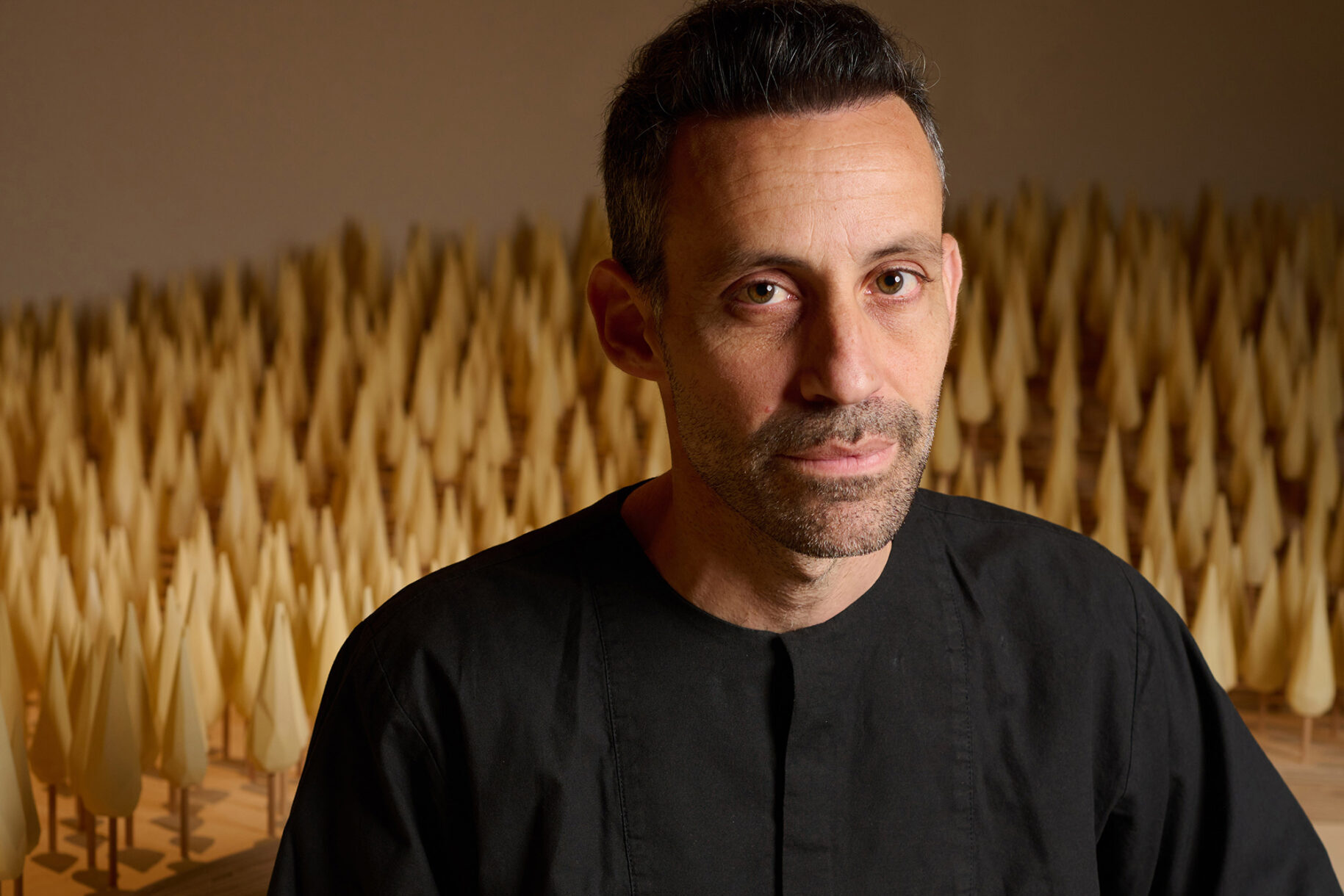
Sustainability
Delaney Rebernik|Books
Head in the boughs: ‘Designed Forests’ author Dan Handel on the interspecies influences that shape our thickety relationship with nature
Recent Posts
Love Letter to a Garden and 20 years of Design Matters with Debbie Millman ‘The conscience of this country’: How filmmakers are documenting resistance in the age of censorship Redesigning the Spice Trade: Talking Turmeric and Tariffs with Diaspora Co.’s Sana Javeri Kadri “Dear mother, I made us a seat”: a Mother’s Day tribute to the women of IranRelated Posts

Design Juice
Rachel Paese|Interviews
A quieter place: Sound designer Eddie Gandelman on composing a future that allows us to hear ourselves think

Design of Business | Business of Design
Ellen McGirt|Audio
Making Space: Jon M. Chu on Designing Your Own Path

Design Juice
Delaney Rebernik|Interviews
Runway modeler: Airport architect Sameedha Mahajan on sending ever-more people skyward

Sustainability
Delaney Rebernik|Books
